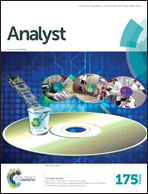Sensitive fluorescence detection of mercury(ii) in aqueous solution by the fluorescence quenching effect of MoS2 with DNA functionalized carbon dots†
Abstract
A rapid and sensitive fluorescent sensor based on the MoS2 nanosheet/DNA/carbon dot nanoassembly has been developed towards the detection of mercury(II) present in environmental samples. Bio-carbon dots (CDs) having strong fluorescence maxima at 451 nm were synthesized via one-step treatment with honey under low temperature carbonization. These CDs were nearly spherical with good size distribution and excellent monodispersity, and the average sizes of CD were around 2–4 nm as evidenced from transmission electron microscopy. The conjugation of DNA strands on the surface of the carbon dots provided an efficient fluorescent probe. The fluorescence of the MoS2 nanosheet/DNA/carbon dot nanoassembly enhanced gradually with the increase in the concentration of Hg2+ ions and the detection limit was found to be 1.02 nM. Furthermore, the fluorescence intensity was found to be linear with the concentration of Hg2+ ions in the range from 0 to 10 nM and their respective coefficient of determination was found to be 0.93676 and 0.98178. The present MoS2 nanosheet/DNA/carbon dot nanoassembly is highly selective toward Hg2+ ions over a wide range of metal ions tested.


 Please wait while we load your content...
Please wait while we load your content...